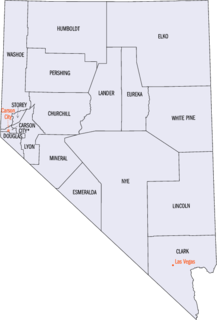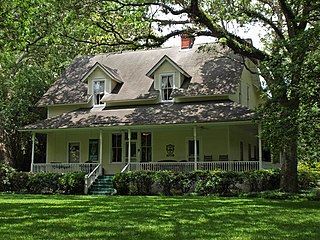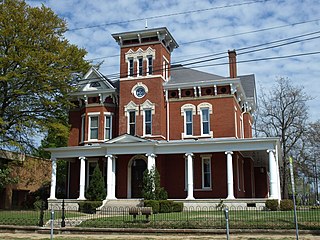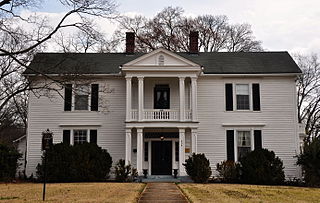
This is a list of properties and historic districts in Nevada that are listed on the National Register of Historic Places. There is at least one listing in each of Nevada's 16 counties and one independent city.

The Thomas C. Carson House is a historic building located in Iowa City, Iowa, United States. It is currently in use as the sorority house of the University of Iowa chapter of Alpha Phi, and is thus also known as the Carson-Alpha Phi House.

The Drewry-Mitchell-Moorer House is a historic mansion in Eufaula, Alabama, U.S.. It was built for Dr. John Drewry in 1867. It remained in the family until the 1970s, having been inherited by Drewry's daughter, Lilly Mitchell, followed by her son, A. C. Mitchell, and his daughter, Mrs. W. D. Moorer. It has been listed on the National Register of Historic Places since April 13, 1972.

The Guild-Verner House is a historic mansion in Tuscaloosa, Alabama, U.S..

The Street House is a historic cottage in Point Clear, Alabama, U.S.. It was built in 1906 for William Street. The house has remained in the family; by the 1980s, it belonged to H. Vaughn Street III. It has been listed on the National Register of Historic Places since December 20, 1988.

The Sunnyside Hotel is a historic house in Magnolia Springs, Alabama, U.S.. It was built in 1897 for Christopher McLennan. It was converted into a hotel by the new owner, Mrs William Harding, in 1913. In the 1940s, it was inherited by her sister and brother-in-law, who used it as a private home until the 1980s, when they sold it to new owners. In 1996, it was sold to David Worthington. It has been listed on the National Register of Historic Places since February 20, 1998.

The Dr. C.A. Thigpen House is a historic mansion in Montgomery, Alabama, U.S.. It was built for Dr. Charles A. Thigpen, a physician, circa 1898. It was designed in the classical style by architect Frank Lockwood. It has been listed on the National Register of Historic Places since December 13, 1977.

The Tyson–Maner House is a historic mansion in Montgomery, Alabama, U.S.. It was built in 1890 for Archibald Pitt Tyson, a former farmer turned real estate developer. It remained in the family until 1930, as it was inherited by his wife Ellen Nicholson Arrington in 1918 and later by their children. By the 1970s, it belonged to Carl Herbert Lancaster, an architect. It has been listed on the National Register of Historic Places since May 10, 1979.

The Winter Building is a historic building in Montgomery, Alabama, U.S..

The Pepperman House is a historic house located at 17 Mildred Street in Montgomery, Alabama.

The Bass-Perry House is a historic house on a former plantation in Seale, Alabama, U.S.

The Samuel R. Pitts Plantation, also known as the Greenwood Plantation or the William J. Benton House, is a historic house on a plantation in Pittsview, Alabama, U.S..

The Bradford-Maydwell House is a historic house in Memphis, Tennessee, U.S.. The plot of land was acquired by W. C. Bradford in 1853; by 1860, it belonged to James Maydwell. The construction of the house began in 1859. It was designed both in the Federal and Italianate architectural style. It has been listed on the National Register of Historic Places since December 26, 1979.

The Fowlkes-Boyle House is a historic house in Memphis, Tennessee, U.S.. It was built circa 1850 for Sterling Fowlkes. It belonged to the Boyle family from 1873 to 1920. It has been listed on the National Register of Historic Places since August 7, 1974.

The Herman J. and Ella B. Voigts House is a historic house in Leawood, Kansas, U.S.. It was built in 1923 for Herman J. Voigts, the president of the First National Bank of Olathe, and his wife Ella Busch. It was designed in the Prairie School architectural style. The couple died in 1970 and 1956 respectively, and their daughter Anna Lois Dubach lived in the inherited house until her death in 1992. It was purchased by Barry Grissom in 1993. It has been listed on the National Register of Historic Places since May 18, 1995.

The Frierson-Coble House is a historic house in Shelbyville, Tennessee, U.S.. It was built in 1835 for Erwin J. Frierson, who was trained as a lawyer by James K. Polk, who went on to serve as the 11th President of the United States from 1845 to 1849. Frierson served as a member of the Tennessee House of Representatives in 1845. In 1888, the house was purchased by Dr Neely Coble, a physician; it was later inherited by his son, Thomas Coble, also a physician. By the 1980s, it still belonged to the Coble family. It has been listed on the National Register of Historic Places since April 12, 1982.

The Nathan Bedford Forrest Boyhood Home is a historic log house in Chapel Hill, Tennessee, U.S.. It was the childhood home of Confederate General and Ku Klux Klan leader Nathan Bedford Forrest from 1830 to 1833. It is owned by the Sons of Confederate Veterans.

The Swaim House is a historic house in Chapel Hill, Tennessee, U.S.. It was built in the 1840s, and designed in the Greek Revival architectural style. It belonged to James Fulton, E. G. Forrest, William Turner and J.F. Brittain until J. M. Swain purchased it in 1893. It remained in the Swaim family until the 1980s, when his great-granddaughter Joy Lewter was the homeowner. The house was extended over the years, with the addition of a rear shed circa 1945 and a garage in 1982. It has been listed on the National Register of Historic Places since July 12, 1984.

Idler's Retreat, also known as the Dillon-Tucker-Cheney House, is a historic house in Smyrna, Tennessee, U.S.. It was built circa 1865 by J. D. Dillon. In 1882, it was purchased by John F. Tucker, and renamed Tucker Place. It was designed in the Greek Revival and Italianate architectural styles. By the 1940s, it was inherited by Brainard Cheney's wife. The couple entertained other writers like Robert Penn Warren, Caroline Gordon, Flannery O'Connor and Allen Tate. The house was later inherited by Roy Neel, who served as the chief of staff to Vice President Al Gore. It has been listed on the National Register of Historic Places since May 19, 2004.






















